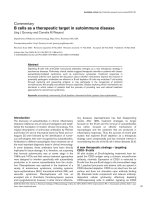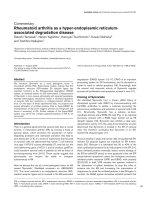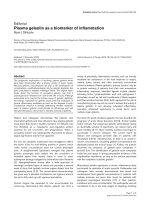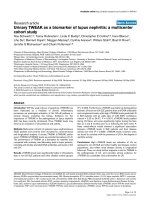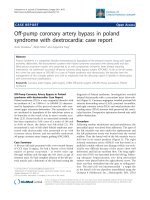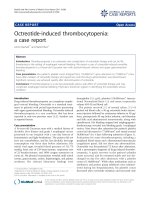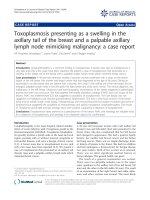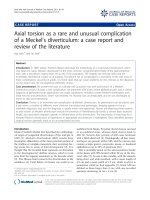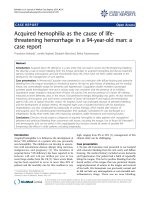Báo cáo y học: "HIV transmission as a result of drug market violence: a case report" pdf
Bạn đang xem bản rút gọn của tài liệu. Xem và tải ngay bản đầy đủ của tài liệu tại đây (183.78 KB, 3 trang )
BioMed Central
Page 1 of 3
(page number not for citation purposes)
Conflict and Health
Open Access
Short report
HIV transmission as a result of drug market violence: a case report
Will Small*
1
, Thomas Kerr
1,2
and Evan Wood
1,2
Address:
1
British Columbia Centre for Excellence in HIV/AIDS, St. Paul's Hospital, 608-1081 Burrard Street, Vancouver, British Columbia, V6Z
1Y6, Canada and
2
Department of Medicine, 2194 Health Sciences Mall, University of British Columbia, Vancouver, British Columbia, V6T 1Z3,
Canada
Email: Will Small* - ; Thomas Kerr - ; Evan Wood -
* Corresponding author
Abstract
While unprotected sexual intercourse and the use of contaminated injection equipment account
for the majority of HIV infections worldwide, other routes of HIV transmission have received less
attention. We report on a case of HIV transmission attributable to illicit drug market violence
involving a participant in a prospective cohort study of injection drug users. Data from a qualitative
interview was used in addition to questionnaire data and nursing records to document an episode
of violence which likely resulted in this individual acquiring HIV infection. The case report
demonstrates that the dangers of drug market violence go beyond the immediate physical trauma
associated with violent altercations to include the possibility for infectious disease transmission.
The case highlights the need to consider antiretroviral post-exposure prophylaxis in cases of drug
market violence presenting to the emergency room, as well strategies to reduce violence
associated with street-based drug markets.
Introduction
Human immunodeficiency virus (HIV) transmission
among injection drug users (IDU) represents a significant
factor driving the global HIV epidemic [1], and HIV inci-
dence remains elevated among this population in numer-
ous settings globally [2]. While the use of contaminated
injection equipment and unprotected sexual intercourse
account for the majority of infections worldwide, other
routes of HIV transmission have received less attention.
For instance, few studies have examined less common
routes of HIV infection [3], and we know of none that
have considered the potential of direct blood-to-blood
contact via violent altercations among IDU. Although HIV
infection through violent interaction is likely rare, the
potential of antiretroviral post-exposure prophylaxis to
reduce the risk of HIV transmission under these circum-
stances makes it important to examine this potential route
of transmission among drug user populations [4,5]. This
may be particularly important given the high rates of drug
market violence among IDU [6].
Case description
We present the circumstances surrounding the HIV infec-
tion of a 39 year old white male who is a participant
within a prospective epidemiological cohort study of IDU
in Vancouver, Canada. In addition to completing a quan-
titative survey which assesses HIV risk behavior, study par-
ticipants also provide a blood sample for HIV testing at
semi-annual visits. As well, the cohort has a concurrent
qualitative component designed to examine HIV serocon-
versions among participants. Qualitative interviews are
conducted with cohort participants who recently received
a positive HIV test result, to collect additional data regard-
ing sexual, and injection behavior in the time prior to
Published: 18 July 2008
Conflict and Health 2008, 2:8 doi:10.1186/1752-1505-2-8
Received: 9 June 2008
Accepted: 18 July 2008
This article is available from: />© 2008 Small et al; licensee BioMed Central Ltd.
This is an Open Access article distributed under the terms of the Creative Commons Attribution License ( />),
which permits unrestricted use, distribution, and reproduction in any medium, provided the original work is properly cited.
Conflict and Health 2008, 2:8 />Page 2 of 3
(page number not for citation purposes)
seroconversion, as well as details regarding potential
sources of infection. Data from qualitative interviews gen-
erate a detailed description of circumstances surrounding
each individual's HIV infection and are triangulated with
cohort data and nursing records from pre-test counselling.
The present case, to whom we have given the pseudonym
'Peter', was defrauded in the street drug market by an indi-
vidual who had sold him "bunk" [counterfeit drugs]
instead of $50 worth of heroin he sought to purchase.
When he next encountered the person who had defrauded
him at a focal point of the local drug market, Peter
attempted to obtain re-imbursement of his $50. When re-
imbursement was refused, a physical altercation ensued,
and the man who defrauded Peter was severely beaten.
The assault was committed using his fists and no biting
was involved. Peter came into contact with large volumes
of the other man's blood, and reported that the skin on
his own hands was broken in a number of places as a
result of punching the victim. Peter reported having been
aware that the victim was possibly HIV infected and that
his open wounds posed potential for infectious disease
transmission. However, he did not seek medical attention
due to his fear of being identified by police.
Early in 2006, approximately 3 months after the incident,
Peter presented to our research office for his semi-annual
HIV test. Reviews of this participant's pre-test counseling
nursing records from this study visit revealed that he sus-
pected that he had been exposed to the HIV virus through
the incident detailed above. In the six months prior to his
positive test result, the present case was injecting drugs but
his questionnaire data revealed that he denied any injec-
tion-related HIV-risks as he primarily injected alone and
did not share syringes or ancillary equipment. Similarly,
while the present case was sexually active in the 6 months
prior to his seroconversion, he reported consistently using
condoms and did not report any unprotected sex.
Discussion
We have described a case of an individual whose HIV
infection appears to be attributable to blood-to-blood
contact which occurred during a violent encounter. The
assault that likely resulted in this infection was sparked by
a conflict in the local street-based drug market. Although
this individual recognized that he had come into contact
with the blood of a person he thought to be HIV positive,
and was cognizant that there was potential for infectious
disease transmission, he did not seek medical assistance.
Although violent encounters, particularly fistfights,
involving HIV positive individuals have previously been
identified as a mode of HIV transmission [3,7,8], this
potential route of transmission has not been commonly
reported, and as far we know, has never been reported
among IDU. The present case suggests that the potential
for HIV exposure should be explored among individuals
involved in violent encounters in high HIV prevalence set-
tings, especially among IDU, since the level of violence
involved in this case is not unique [9,10]. This episode
indicates that the dangers of violence among IDU extend
beyond the immediate physical trauma associated with
violent altercations to include the possibility for infec-
tious disease transmission. The potential for high levels of
violence among IDU to create opportunities for HIV trans-
mission merits consideration of measures to provide
antiretroviral post-exposure prophylaxis to individuals
who have been involved in a violent encounter involving
direct blood contact.
Within illegal drug markets violence is endemic and is
employed for the purposes of punishment and conflict
resolution [9-11], as persons buying or selling drugs in
these markets have no recourse to legitimate authority to
resolve disputes [12,13]. Therefore, effective practical
interventions are needed to reduce the prevalence of drug
market violence and mediate the negative health impacts
that result. Substitution therapies (e.g., methadone, her-
oin prescription) and strategies to regulate or decriminal-
ize particular illicit substances may hold potential to
reduce violence among drug users and community levels
of violence in neighborhoods where street-based drug
markets currently operate [14].
Since the current study did not undertake phylogenetic
analysis, it is not possible to be absolutely certain that the
described assault on an HIV-positive male was the source
of this individual's infection. However, given that blood
contact resulting from violence has previously been docu-
mented as a route of HIV transmission, the details of this
case do support the conclusion that an assault was very
likely the source of infection. Additionally, comparison of
data from study records and the qualitative interview
revealed a high level of consistency in reported behavior
and agreement between data sources.
Authors' contributions
WS conducted the analyses of the interview data and pre-
pared the first draft of the article. All authors contributed
to the design of the study as well to the drafting and revi-
sion of the manuscript. All authors have approved the
final manuscript.
Acknowledgements
The authors wish to thank the study participants for their time and partic-
ipation. We also thank the administrative staff at the B.C. Centre for Excel-
lence in HIV/AIDS, as well as the VIDUS and SEOSI study staff for their
research assistance.
Publish with Bio Med Central and every
scientist can read your work free of charge
"BioMed Central will be the most significant development for
disseminating the results of biomedical research in our lifetime."
Sir Paul Nurse, Cancer Research UK
Your research papers will be:
available free of charge to the entire biomedical community
peer reviewed and published immediately upon acceptance
cited in PubMed and archived on PubMed Central
yours — you keep the copyright
Submit your manuscript here:
/>BioMedcentral
Conflict and Health 2008, 2:8 />Page 3 of 3
(page number not for citation purposes)
Funding for this research was provided by the Canadian Institutes of Health
Research (CIHR) operating grant, "Exploring the natural history of injection
drug use: social and environmental influences".
Mr Small is supported a Michael Smith Foundation for Health Research
(MSFHR) Senior Graduate Studentship and a CIHR Doctoral Research
Award. Dr Kerr is supported by a MSFHR Scholar Award and a CIHR New
Investigator Award.
References
1. Joint United Nations Programme on HIV/AIDS (UNAIDS): Report
on the Global AIDS Epidemic by the Joint United Nations
Programme on HIV/AIDS. , UNAIDS; 2006.
2. Aceijas C, Stimson GV, Hickman M, Rhodes T: Global overview of
injecting drug use and HIV infection among injecting drug
users. Aids 2004, 18:2295-2303.
3. Gilbart VL, Raeside F, Evans BG, Mortimer JY, Arnold C, Gill ON,
Clewley JP, Goldberg D: Unusual HIV transmissions through
blood contact: analysis of cases reported in the United King-
dom to December 1997. Commun Dis Public Health 1998,
1:108-113.
4. Mackie NE, Coker RJ: Post-exposure prophylaxis following non-
occupational exposure to HIV: risks, uncertainties, and eth-
ics. Int J STD AIDS 2000, 11:424-427.
5. Omrani AS, Freedman A: Prophylaxis of HIV infection. Br Med
Bull 2005, 73-74:93-105.
6. Kerr T, Small W, Wood E: The public health and social impacts
of drug market enforcement: A review of the evidence. Inter-
national J Drug Policy 2005, 16:210-220.
7. Emerson CR, Quah SP: Transmission of HIV-1 infection due to
a fist fight. Int J STD AIDS 2008, 19:131-132.
8. O'Farrell N, Tovey SJ, Morgan-Capner P: Transmission of HIV-1
infection after a fight. Lancet 1992, 339:246.
9. Singer M, Simmons J, Duke M, Broomhall L: The challenges of
street research on drug use, violence, and AIDS risk. Addiction
Research & Theory 2001, 9:365-404.
10. Fagan J, Chin K: Violence as regulation and social control in the
distribution of crack. In Drugs and Violence: Causes, Correlates, and
Consequences Edited by: De La Rosa M, Lambert EY and Gropper B. ,
NIDA; 1990:8-42.
11. Maher L: Sexed Work: Gender, Race, and Resistance in a
Brooklyn Drug Market. , Oxford University Press; 2000.
12. Sterk CE, Elifson K: Drug-related violence and street prostitu-
tion. Drugs and Violence: Causes, Correlates, and Consequences
1990:208-220.
13. Parker RN, Auerhahn K: Alcohol, drugs, and violence.
Annu Rev
Sociol 1998, 24:291-311.
14. Erickson PG: Drugs, Violence and Public Health: What does
the harm reduction approach have to offer. , Fraser Institute;
2001.

